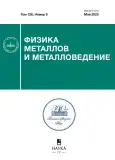卷 126, 编号 5 (2025)
ЭЛЕКТРИЧЕСКИЕ И МАГНИТНЫЕ СВОЙСТВА
MAGNETIZATION CURVES FOR LITHIUM-COBALT AND LITHIUM-NICKEL ORTHOPHOSPHATES
摘要
The magnetization curves of nanocomposites with LiCoPO4, LiNiPO4 and LiNi0.5Co0.5PO4 orthophosphate particles have been studied in the low temperature range. The measurements were performed both on direct current and in alternating fields. The dependence of the magnetic susceptibility on the magnetic field in alternating fields and the susceptibility measured at direct current is compared. An anomalous maximum of susceptibility is observed in a field with a strength of about ~ 32 kOe, which can be interpreted as a consequence of an additional reversal of magnetic moments. A formula is proposed to describe the field dependence of magnetic susceptibility in alternating fields.
 511-519
511-519


STRUCTURE AND MAGNETIC PROPERTIES OF THIN HEMATITE FILMS ON THE с-Al2O3 SUBSTRATES
摘要
The structural and magnetic properties of hematite (α-Fe₂O₃) thin films with thicknesses ranging from 5 to 250 nm, grown by magnetron sputtering on c-Al₂O₃ substrates, have been investigated. The evolution of the lattice parameters with increasing film thickness has been analyzed. Experimental results show that the in-plane lattice parameters and the corresponding mechanical strain, arising from the lattice mismatch between the film and the substrate, gradually decrease with increasing film thickness. It is demonstrated that the Morin transition disappears as the thickness decreases from 250 to 162 nm and is not observed in thinner films. The magnetization continuously decreases with decreasing film thickness. Ab initio calculations of the structural parameters were performed, highlighting the importance of taking structural defects into account to describe adequately the observed trends.
 520-534
520-534


BERRY PHASE AND MAGNETOTRANSPORT EVIDENCES FOR NONTRIVIAL TOPOLOGY IN THE ELECTRONIC BAND STRUCTURE OF HGSE
摘要
Longitudinal and transverse magnetotransport effects were investigated in a monocrystalline HgSe sample (electron concentration n = 4 × 1016 cm−3, electron mobility µ = 1.2 × 10⁵ cm² V−1 s−1) under a planar electric and magnetic field configuration. Analysis of Shubnikov-de Haas oscillations in both longitudinal and transverse magnetoresistance yielded data on the half-filling of the zeroth Landau level and revealed a nontrivial Berry phase. These signatures of the relativistic nature of the HgSe electronic spectrum are complemented by two key magnetotransport signatures of the chiral anomaly: the chiral magnetic effect and the planar Hall effect. Collectively, these findings indicate the existence of a Weyl semimetal electronic topological phase in HgSe — an isotropic, nonmagnetic material characterized by strong spin-orbit coupling.
 535-546
535-546


The Influence of Skin Effect on Frequency Dependence of Dynamic Permeability in Ferromagnetic Films
摘要
 547-555
547-555


СТРУКТУРА, ФАЗОВЫЕ ПРЕВРАЩЕНИЯ И ДИФФУЗИЯ
Surface tension of ternary systems with minima on the surface tension isotherms of binary melts
摘要
 556-563
556-563


Microstructural aspects of additive friction stir welding of chrome-zirconium bronze
摘要
 564-574
564-574


COMPARATIVE ANALYSIS OF THERMAL STABILITY OF AMORPHOUS STRUCTURE IN Fe40Ni40P14B6 AND Fe48Co32P14B6 METALLIC GLASSES
摘要
Crystallization kinetics of Fe40Ni40P14B6 and Fe48Co32P14B6 glasses at isothermal conditions was investigated in the temperature ranges of 617–662 and 683–714 K, respectively. The onset crystallization times were used as indicators of thermal stability. The transient behavior of crystal nucleation was established in the framework of the Kolmogorov–Johnson–Mehl–Avrami model and the combined Kolmogorov–Kashchiev model and both the degrees of non-stationarity and the times characterizing crystallization kinetics at steady-state and transient nucleation were determined. The temperature dependencies of the effective diffusivity governing transfer atoms across the interfaces and steady-state nucleation rates were calculated using the characteristic steady-state crystallization times and values of the crystal growth rates known from the literature. From these data the temperature dependencies of both the work of critical nucleation formation and the specific free energy of nucleus/matrix interface were found in the framework of the classical equation of homogeneous nucleation rate. From comparison between the experimentally measured and calculated for steady-state nucleation onset crystallization times it was established that the enhanced thermal stability of Fe48Co32P14B6 compared with that of Fe40Ni40P14B6 was caused by the lowered diffusion mobility and the higher degree of deviation of nucleation rate from its steady-state value.
 575-588
575-588


Influence of thermo- and mechanocycling on thermoelastic martensitic transformations, microstructure and properties (α+β) of Cu–39.5 wt% Zn alloy with shape memory effects
摘要
 589-597
589-597


The Effect of Isothermal Multidirectional Forging on the Microstructure and Properties of Cu–40%Zn–2%Mn Alloy
摘要
 598-607
598-607


The evolution of the microstructure of Cr16–Ni19 steel under neutron irradiation at initial stage of radiation swelling
摘要
 608-618
608-618


The Effect of Low-Energy Nitrogen Ion Implantation on Surface Hardening and High-Temperature Oxidation of Niobium-Molybdenum Alloys
摘要
 619-628
619-628


ПРОЧНОСТЬ И ПЛАСТИЧНОСТЬ
Study of the structure and properties of aluminum-matrix composites based on technical aluminum, reinforced with multi-walled carbon nanotubes
摘要
Alumina-matrix composites reinforced with multi-walled carbon nanotubes (MWCNTs) in the cast state were obtained by introducing powders of different compositions containing MWCNTs, Cu and/or Mg metals, and SiC ceramic particles into the Al melt. The structure of the composites was studied using light and scanning electron microscopy. It was found that the powder composition affects the effect of modifying the structure of aluminum matrix composites. The most dispersed structure (grain size 200 μm) is found in composites reinforced with MWCNTs with a microadditive of Mg. The hardness and mechanical properties of the composites were measured in a wide range of deformation rates (έ = 10–2 – 105 s–1). Experiments on loading aluminum matrix composites with plane shock waves were performed for the first time. From these data it follows that with an increase in the deformation rate, a gradual increase in the yield strength of composites up to 100 MPa is observed. A comparison of the strength characteristics of aluminum matrix composites with the corresponding characteristics of unreinforced Al shows that the strengthening effect of MWCNTs is more pronounced at higher deformation rates and reaches 60% at the maximum deformation rate.
 629-640
629-640










